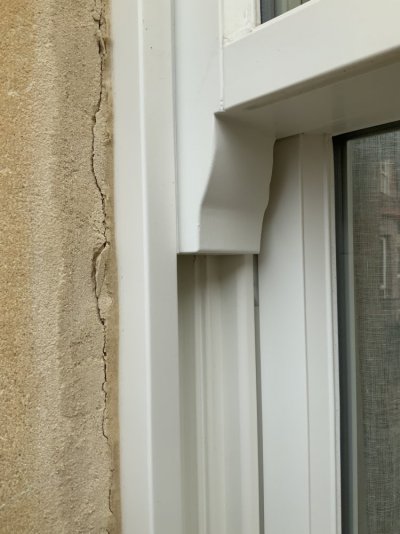G'day all,
I'm working on arched windows in a bluestone building. The sill was rotting away and opted for cutting out and replacing the worst of it with hardwood, rather than the whole thing.
The lime around the frame is mostly gone and gaps between 2-5mm are letting water in, which runs down and gathers under the sill. The stone is angled inside, which explains why the sill was rotting in and behind more than on the front and surface. The rebate in the stone is cavernous and was very wet. The wooden sill is flush with the stone, no drip channel, so I think a lot of water gets in under the sill gap and runs backwards too.
After repairing as much as I could, I've undercoated and reglazed the glass with linseed oil putty and blended it in with the old glaze, which is all intact. Waiting to paint the frame.
I live in Australia and oakum is very difficult and expensive to get, but I understand it's the ideal thing to use between timber and stone. Then you follow it up over the top with your lime pointing. Hopefully any deep rot that remains will stabilize if I can keep the water out.
Two questions: Because most of the gaps are so narrow, is it okay to not use oakum and just generously lime the cavity between the timber and the stone? It's almost stone on timer in some places. If not, what about the linseed oil putty for glazing? It's suitable for plumbing work too, so surely it would be a good, breathable seal? Has anyone tried it? Clearly it works well between glass and timber, what about stone and timber? Can you lime over linseed oil putty? Let me know if you have experience with any other sealers.
Cheers;

I'm working on arched windows in a bluestone building. The sill was rotting away and opted for cutting out and replacing the worst of it with hardwood, rather than the whole thing.
The lime around the frame is mostly gone and gaps between 2-5mm are letting water in, which runs down and gathers under the sill. The stone is angled inside, which explains why the sill was rotting in and behind more than on the front and surface. The rebate in the stone is cavernous and was very wet. The wooden sill is flush with the stone, no drip channel, so I think a lot of water gets in under the sill gap and runs backwards too.
After repairing as much as I could, I've undercoated and reglazed the glass with linseed oil putty and blended it in with the old glaze, which is all intact. Waiting to paint the frame.
I live in Australia and oakum is very difficult and expensive to get, but I understand it's the ideal thing to use between timber and stone. Then you follow it up over the top with your lime pointing. Hopefully any deep rot that remains will stabilize if I can keep the water out.
Two questions: Because most of the gaps are so narrow, is it okay to not use oakum and just generously lime the cavity between the timber and the stone? It's almost stone on timer in some places. If not, what about the linseed oil putty for glazing? It's suitable for plumbing work too, so surely it would be a good, breathable seal? Has anyone tried it? Clearly it works well between glass and timber, what about stone and timber? Can you lime over linseed oil putty? Let me know if you have experience with any other sealers.
Cheers;
Last edited:

